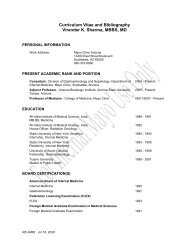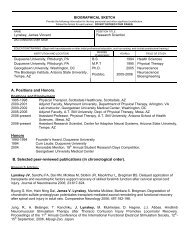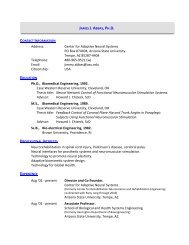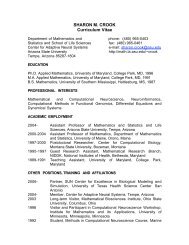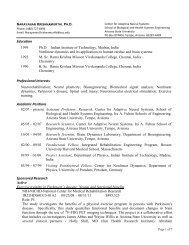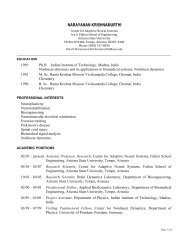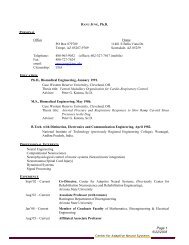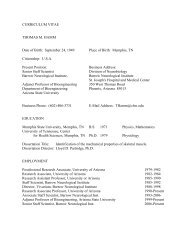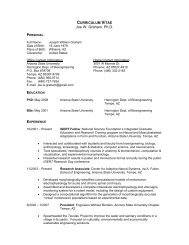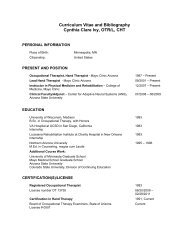ASU FC S 04 - Center for Adaptive Neural Systems - Arizona State ...
ASU FC S 04 - Center for Adaptive Neural Systems - Arizona State ...
ASU FC S 04 - Center for Adaptive Neural Systems - Arizona State ...
You also want an ePaper? Increase the reach of your titles
YUMPU automatically turns print PDFs into web optimized ePapers that Google loves.
School News<br />
Technology Institute (URETIs) Institute <strong>for</strong> “Cell Mimetic Space<br />
Exploration” (CMISE).<br />
MIMIC is a student-run multi-institutional collaborative project to<br />
design and build a microsatellite to measure the residual magnetic field at<br />
Mars. <strong>ASU</strong> is leading a collaboration among eight different universities<br />
from all over the country. The concept study is a project initiated by the<br />
NASA Jet Propulsion Lab.<br />
Building satellites between classes<br />
The program is modeled after industry but it is not industry. The<br />
workers are students learning as they go and trying to fit in school projects,<br />
homework and exams while building satellites.<br />
This is the first time AFRL has worked with universities in this<br />
capacity. “Although the nature of working with students is unstable,<br />
this week is midterms, that week is finals, people graduate and new<br />
students join the team,” said Jeff Ganley of AFRL, “the university students<br />
do very well compared to industry in terms of per<strong>for</strong>mance. I<br />
enjoy working with students.”<br />
It’s a win-win situation<br />
According to Ganley the benefits of this program are many. AFRL's<br />
interest is in developing the high risk technology area of small satellites,<br />
as well as educating our future work<strong>for</strong>ce in systems engineering. “The<br />
students get to learn the non-book stuff.” said Ganley. “They learn real<br />
world systems engineering by building the satellite. They get a chance<br />
to experience working in teams, schedule and budget constraints.” He<br />
said, “The students are great at coming up with crazy, innovative solutions<br />
which fit perfectly with a developing technology area like small<br />
satellites.”<br />
While building satellites alone gives the students a great advantage<br />
when entering the job market, working with groups at a distance<br />
makes the experience all the more true to life. Companies are seeing<br />
the benefits of programs like the one at <strong>ASU</strong>. “Companies come to the<br />
career fairs and want these students.” Reed said. “Companies contact<br />
me to see if anyone is graduating soon.” The space industry gets graduates<br />
that are ready to go straight to work, without having to train them<br />
about life in the real world.<br />
The story continues<br />
According to Reed, the original mission of the <strong>ASU</strong> Student Satellite<br />
Program was to link the university program to local industry, but as the<br />
program has grown so has the mission. Today the students are linked<br />
with industry, government and other students around the nation. She<br />
said, “We are always trying to evolve the program.”<br />
For the past decade, Helen Reed, professor of<br />
mechanical and aerospace engineering, has helped<br />
students build satellites. The Air Force will launch<br />
their latest collaborative ef<strong>for</strong>t, the Three Corner<br />
Satellite, this July from the Kennedy Space <strong>Center</strong>.<br />
As far as the future goes <strong>for</strong> students building satellites, Reed said, “I<br />
see it growing with university students very excited about space.” She<br />
hopes to see this type of program extend far beyond university students<br />
to space programs at the K-12 level. Reed wants “the <strong>ASU</strong> program to<br />
be at the <strong>for</strong>efront of having students create smaller more elegant systems.”<br />
“I do it because it is most satisfying when a student gets it,” said<br />
Reed.<br />
For more in<strong>for</strong>mation about the <strong>ASU</strong>Sat and NASA Space<br />
Grant programs, see http://nasa.asu.edu.<br />
IRA A. FULTON SCHOOL OF ENGINEERING – SPRING 20<strong>04</strong> 5



